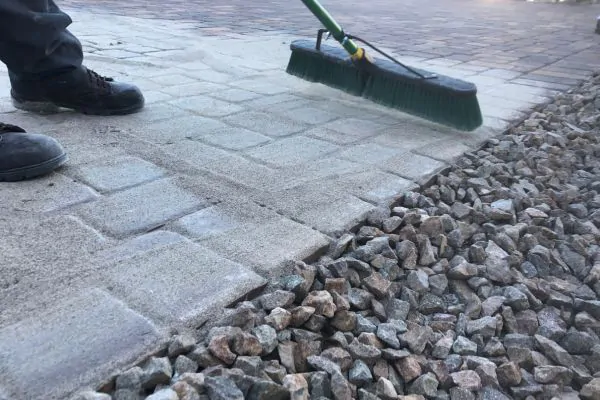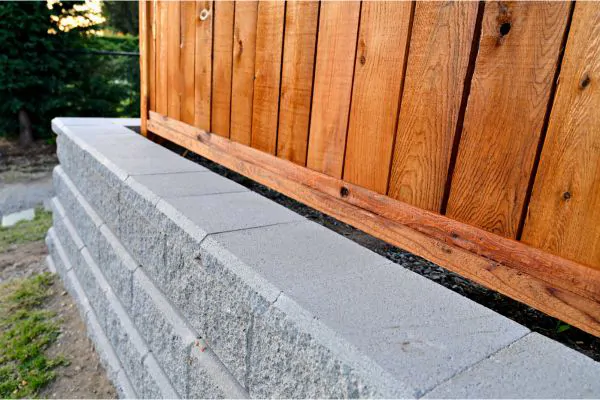Discover the secret to maintaining pristine patios and walkways as we explore the battle against the unsightly white haze known as efflorescence.
Whether gracing your brickwork with ghostly streaks or conspiring against the natural beauty of your stone surfaces, efflorescence in pavers casts an aesthetic pall that no homeowner enjoys.
Equipped with the right knowledge and tools, banishing these persistent salts becomes less an ordeal and more a straightforward task. Keep reading to learn the strategies that can restore the charm and integrity of your hardscaped masterpieces.
What is Efflorescence?

Elegant patios, walkways, and walls owe their beauty to the use of pavers and stone, but over time, an unwelcome guest, efflorescence, can mar their appearance. Efflorescence is a crystalline deposit of salts often seen as a white powdery substance that can surface on pavers, bricks, and stone. These deposits occur when water moves through a wall or floor, carrying with it soluble salts to the surface and leaving a residue as the water evaporates.
Understanding the origin of efflorescence is key to its successful removal. It’s not simply a matter of aesthetics; if left unaddressed, efflorescence can eventually contribute to the deterioration of pavers, stone, or brickwork. The formation of efflorescence is particularly prevalent in areas with significant temperature fluctuations and moisture presence:
- Water seeps into porous materials like bricks and stone.
- As the water moves, it dissolves and carries salts within the material.
- A drop in temperature or a decrease in humidity causes the water to evaporate.
- Evaporation leaves behind the salts on the surface, manifesting as efflorescence.
Effectively tackling efflorescence on stone requires proper identification of the salts and understanding that their presence often indicates excess moisture within the material. Engaging in the correct methods of cleaning efflorescence not only restores the visual appeal of the masonry but also protects its structural integrity. A proactive approach to managing moisture and regular maintenance can mitigate the reoccurrence of these salty deposits.
Unmasking the Causes of Paver Efflorescence
Efflorescence on pavers emerges from the interaction between water and salts within the porous materials, triggered by moisture infiltration from rain, dew, or irrigation. Spotting this residue indicates deeper moisture penetration. The material quality and minerals like calcium sulfate influence efflorescence likelihood, emphasizing careful material selection during installation.

Construction practices, drainage systems, and sealing play pivotal roles in preventing water from rising to paver surfaces. Maintenance and climate influence efflorescence severity. Regions with frequent wet-dry cycles demand vigilant upkeep to reduce its impact.
Regular checks for moisture ingress aid in early efflorescence detection, which is crucial for halting deposits’ development. Proactive steps in these challenging environments are essential for mitigating efflorescence. Timely intervention prevents deposits from becoming persistent and harder to remove, safeguarding paver aesthetics and durability.
Proactive Strategies to Shield Your Pavers
Preventing efflorescence involves minimizing water exposure and enhancing drainage near pavers. Proper installation with a slope reduces water absorption, curbing efflorescence risk. Installers must prioritize these water management techniques during construction for lasting paver durability.

Sealers act as barriers, preventing water and salt penetration. Property owners should choose suitable, high-quality sealants for their pavers or stones, applying them soon after installation and maintaining them regularly for continued protection.
Early intervention, like rerouting downspouts, mitigates efflorescence. Addressing moisture signs promptly minimizes salty deposits, preserving pavers’ aesthetics and integrity. Simple adjustments can significantly reduce efflorescence impact, ensuring long-lasting paver appeal.
Effective Removal Methods for Efflorescence
When it comes to extricating efflorescence from bricks, pavers, and stone surfaces, a multi-faceted approach ensures property owners can reclaim the natural elegance of their hardscaping elements.
Addressing the white, chalky substance necessitates methods tailored to the intensity and pervasiveness of the deposits.
A thorough brushing can sometimes be sufficient for mild cases, while persistent or large areas may require a more rigorous solution such as a vinegar mixture or pressure washing.
Each strategy offers a unique benefit in the quest to restore and maintain masonry surfaces free of unsightly efflorescence.
1. Brushing
Initiating the removal process, brushing stands out as a gentle yet effective technique to address the powdery layer of efflorescence. With a stiff-bristled brush, property owners can dislodge and sweep away the surface deposits, revealing the original color and texture of the affected masonry:
- Choose a brush with stiff bristles suitable to remove efflorescence on stone, pavers, bricks, and other surfaces.
- Gently scrub the efflorescence-affected areas in a circular motion to break up the salt deposits.
- Sweep or rinse away the loosened efflorescence to assess the need for further cleaning.
2. Vinegar Solution
Should the initial brushing prove insufficient, a vinegar solution may serve as a potent ally in the crusade against stubborn efflorescence. A measured blend of white vinegar and water creates an acid solution capable of breaking down the salts responsible for the deposits:
Step 1: Mix equal parts white vinegar and water to create a cleaning solution.
Step 2: Apply the mixture directly onto the efflorescent areas, allowing it to penetrate and dissolve the crystalline salts.
Step 3: After a brief period, rinse the surface thoroughly with clean water to prevent the acid from damaging the pavers or stone.
3. Pressure Washing
Utilizing pressure washing is a robust technique in removing efflorescence from brick, particularly in more stubborn cases. Property owners often resort to this forceful method to eliminate layers of calcified salt deposits, swiftly revitalizing the appearance of their hardscapes. Proper caution is essential to ensure that the high-pressure stream effectively cleans without compromising the integrity of the underlying pavers or stones affected by efflorescence. If you’re wondering how to get rid of efflorescence effectively, employing a careful approach with pressure washing can yield rapid and satisfactory results.
Restoring the Beauty of Your Stonework
Maintaining stonework’s allure demands a precise response to efflorescence, particularly when it affects stone surfaces. Understanding how to remove efflorescence and how to clean efflorescence is vital. Removing efflorescence from brick or stone requires a strategic approach, such as using pressure washing carefully to eliminate the milky veil without harming the intricate stonework.
Restoring stone marred by efflorescence requires specific techniques. Diluted vinegar solutions serve as intensive treatments, penetrating porous surfaces to dislodge salts and revive the stone’s natural luster. Attention to this cleaning process reinstates the stone’s pristine condition, preserving the beauty of the property’s hardscape.

Regular application of quality sealants serves as a defense against efflorescence. These sealants protect the stone from water ingress and salt accumulation, sustaining both aesthetic appeal and structural integrity. Consistent maintenance and proactive protective measures ensure the lasting splendor of any stone or masonry installations.
Hire professional for Prevention and Remedies
Entrusting a professional with efflorescence removal ensures a thorough, safe process for delicate surfaces like pavers, bricks, or stone, especially when dealing with efflorescence on pavers. Experts wield precise tools and advanced techniques, applying sealants to prevent future occurrences and safeguarding property aesthetics and structural integrity, specifically targeting efflorescence in pavers.
Their expertise isn’t limited to removal; they pinpoint underlying causes and devise tailored prevention strategies, effectively addressing efflorescence on pavers. This minimizes repetitive cleaning and prevents exacerbation of efflorescence issues, offering a more permanent fix for efflorescence in pavers.
Qualified masonry professionals provide a seamless blend of service and expertise in handling efflorescence on pavers. Their care instills confidence that stonework beauty and integrity are in capable hands. Homeowners can rely on meticulous attention to detail, ensuring enduring, visually pleasing results in addressing efflorescence in pavers. Engaging professionals becomes an investment in property longevity, ensuring efflorescence remains a distant concern while preserving the allure of delicate surfaces like pavers.
Conclusion
Efflorescence, a powdery salt residue, commonly affects pavers, bricks, and stones, gradually diminishing their appeal and causing damage. Recognizing its root causes—water infiltration and salt deposits—is essential for effective treatment. Implementing preventive measures during installation, such as sealants and proper maintenance, can help maintain the integrity of masonry surfaces. When facing stubborn cases of efflorescence on stone or brick, techniques like brushing, using vinegar, or employing pressure washing can aid in restoration.
Seeking professional assistance provides specialized methods for removing efflorescence from brick or stone and implementing preventive strategies. This ensures long-lasting beauty and structural strength. Dealing with efflorescence is crucial, as it not only diminishes aesthetics but also poses a threat to structural integrity. Shielding surfaces from efflorescence safeguards their allure and durability, offering protection against its damaging effects.





